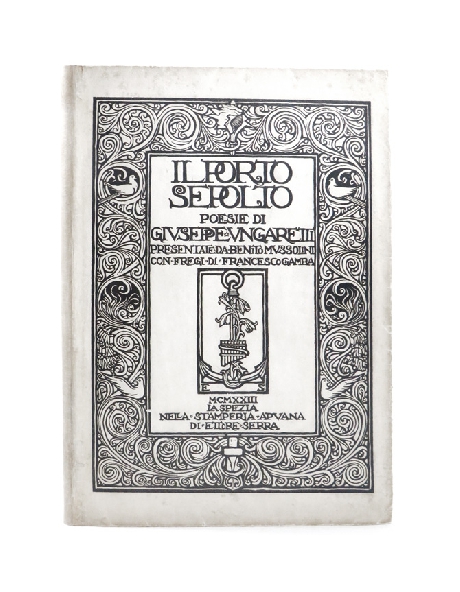

| Non hai nessun prodotto nel carrelloCHIUDI X |
Giuseppe Ungaretti
Il porto sepolto
La Spezia, Stamperia Apuana di Ettore Serra, 1923.
First edition.
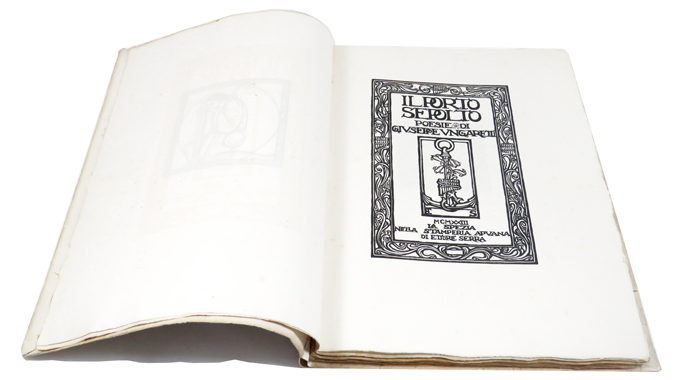
A story of the edition
Though it bears the same title as Ungaretti’s first book (published in 1916), there are so many variants in the text and so many unpublished poems that this cannot be considered a second edition: it is at least a first edition thus – if not a true first edition in its own right.
The printer and poet Ettore Serra had fought by Ungaretti’s side in the trenches and published his poems in the extraordinarily rare book Il porto sepolto (“The sunken harbour”, 1916), one of the most important Italian poetry collections of the Twentieth century whose print run consisted of a meagre 80 copies. Having remained friends, Serra decided to print a deluxe edition of Ungaretti’s verse: modified to varying degrees, 30 of the 33 poems published in The sunken harbour and 26 from Allegria di naufragi (“Joy of shipwrecks”, 1919) appear in the book along with a few unpublished poems. The previously published poems differ so significantly from those that had appeared in both The buried harbour and Joy of shipwrecks that they take on a new form in this book and make it a true first edition and not a mere second.
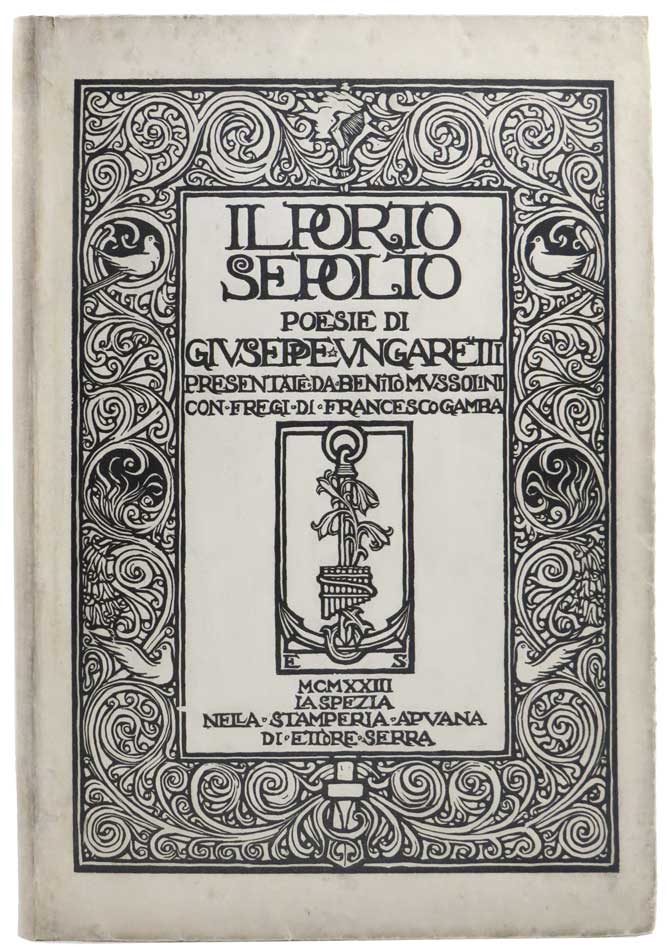
Born in Alexandria in Egypt, Ungaretti had moved to Paris for a spell before the war; in 1923, when this book was published, he was living in Italy and working for the Italian Ministry of Foreign Affairs as well as contributing to a number of Italian and French periodicals and frequently travelling for conferences.
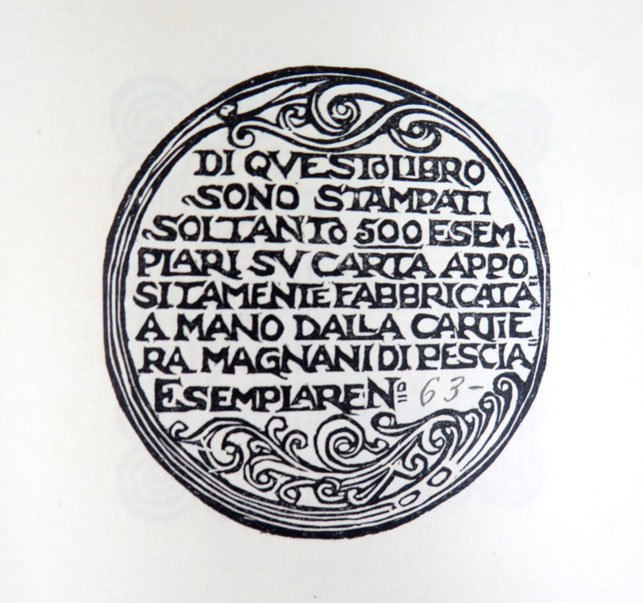
One of the most aesthetically pleasing books of the Italian Twentieth century
The book is entirely illustrated by Francesco Gamba: his Fifteenth-century-style woodcuts, clearly influenced by Pre-Raphaelite art (Gamba had been raised in England and Scotland), are simple and striking at once: each depicted object sits in an ornate frame, alone before the background. In place of a half title there is a drinking female wayfarer with a haversack and a walking stick; the tittle page is similar to the cover (though the woodcut is smaller and a few details differ) and a medallion appears before Mussolini’s preface, which is concise but vigorous: he asserts that he is «not writing as a reviewer: those who shall read these pages shall find themselves facing a profound poetical testimony consisting of sensitivity, torment, research, passion and mystery». (Having worked as a correspondent from Paris for Mussolini’s paper Il popolo d’Italia, Ungaretti was on good terms with him.)
The opening poem, Sirene (“Mermaids”, dedicated to Jean Paulhan), stands apart from the other poems, which are divided into three sections: each is opened by two leaves printed recto depicting the title of the section in a medallion followed by a full-page woodcut:Section Woodcut Elegie e madrigali Naked aulete Allegria di naufragi Naked female bather Porto sepolto Reclining soldier The poems in the second and third sections, modified and rearranged, come from the eponymous collections Ungaretti had published in 1919 and 1916 respectively; the unpublished poems (along with three from Allegria di naufragi and one printed in the periodical «La ronda» in 1921) are concentrated in the first section; the opening poem Sirene was also unpublished.
Ungaretti was an established member of Europe’s elite cultural landscape; to prove this he dedicated most of these poems to many of the more prominent artists of the early Twentieth century (Aragon, Carrà, Breton, De Chirico, Valéry, Paulhan and Apollinaire are among them).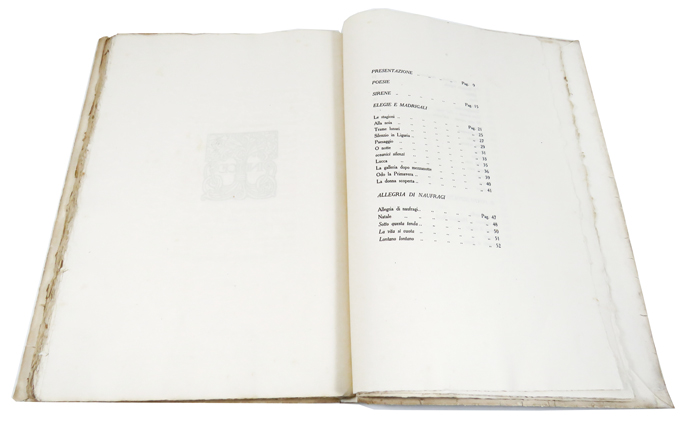
The extraordinary poems, the superbly elegant layout, the fine quality of the paper (made especially by a prestigious paper mill with a watermark reading «E S», Ettore Serra’s initials) and the woodcuts make this one of the most aesthetically pleasing books of the Italian Twentieth century.
Conditions
White wrappers and printed dust jacket (elegant woodcut by Francesco Gamba to the front wrapper, depicting an anchor wrapped in ivy with a pan flute resting on it; Pre-Raphaelite frame runs near the margins; the letters that make up the author’s name and title are also woodcut), in 4° (350 x 246 mm); pp. 133 [15], woodcuts in the text. Copy 188 of 500 numbered copies, exceptionally well preserved.
Bibliography
Mario Barenghi, Da un porto all’altro: Ungaretti 1923 (in Id., Ungaretti: un ritratto e cinque studi, Modena: Mucchi, 1999, pp. 131ss.)
Francesca Corvi, Giuseppe Ungaretti: Il porto sepolto (1922): Un libro inedito (Milano: Biblioteca di via Senato, 2005)
Giampiero Mughini, Da Italo Svevo a Maurizio Cattelan: i 51 libri italiani più belli degli ultimi cento anni (in Una casa romana racconta, Milano: Bompiani, 2013, pp. 181-255)
Rosy Cupo, Ungaretti poeta organico? Per una lettura ideologica delle varianti del Porto sepolto (1923) (in Filologia italiana 8, 2011, pp. 209-229).
Libreria Antiquaria Pontremoli P.IVA 10060360962 | © 2024 Web & Com ® | Area riservata

 MENU
MENU